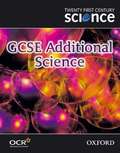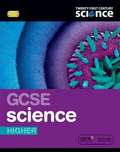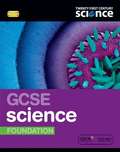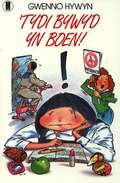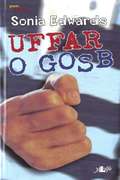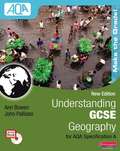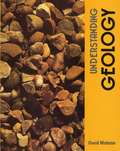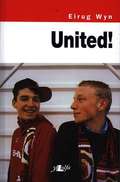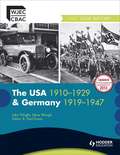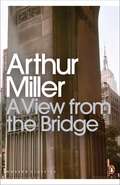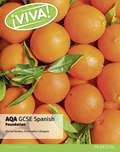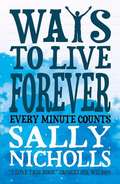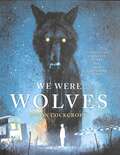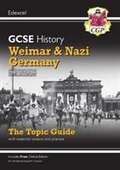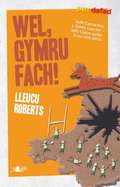- Table View
- List View
Twenty First Century Science: student book (PDF)
by Lynn Winspear Robin Millar Carol Tear Nick Owens Simon Carson Andrew Hunt Jean Martin Stephen Pople Bill Indge Jenifer Burden John Lazonby Allan Mann Anna Grayson John HolmanTwenty First Century Sciencenbsp; isnbsp;a suite of complementary specifications offering flexible and exciting options for science at GCSEnbsp; is unique in having been extensively trialled over three years with more than 6,000 students in each yearnbsp; is motivating, stimulating and relevant.nbsp; The specifications and resources are the products of close collaboration between the University of York Science Education Group, the Nuffield Curriculum Centre, OCR, and Oxford University Press.nbsp; The GCSE Additional Science course contains nine modules: B4 Homeostasisnbsp; B5 Growth and developmentnbsp; B6 Brain and mindnbsp; C4 Chemical patternsnbsp; C5 Chemicals of the natural environmentnbsp; C6 Chemical synthesisnbsp; P4 Explaining motionnbsp; P5 Electric circuitsnbsp; P6 The wave model of radiation.nbsp;
Twenty First Century Science: student book
by Lynn Winspear Robin Millar Carol Tear Nick Owens Simon Carson Andrew Hunt Jean Martin Stephen Pople Bill Indge Jenifer Burden John Lazonby Allan Mann Anna Grayson John HolmanTwenty First Century Sciencenbsp; isnbsp;a suite of complementary specifications offering flexible and exciting options for science at GCSEnbsp; is unique in having been extensively trialled over three years with more than 6,000 students in each yearnbsp; is motivating, stimulating and relevant.nbsp; The specifications and resources are the products of close collaboration between the University of York Science Education Group, the Nuffield Curriculum Centre, OCR, and Oxford University Press.nbsp; The GCSE Additional Science course contains nine modules: B4 Homeostasisnbsp; B5 Growth and developmentnbsp; B6 Brain and mindnbsp; C4 Chemical patternsnbsp; C5 Chemicals of the natural environmentnbsp; C6 Chemical synthesisnbsp; P4 Explaining motionnbsp; P5 Electric circuitsnbsp; P6 The wave model of radiation.nbsp;
Twenty First Century Science: GCSE Science Higher - Student Book (PDF)
by Vicky Wong Helen Harden Neil Ingram David Sang Elizabeth Swinbank Andrew Hunt Ann Fullick Jacqueline PunterThe second edition of the Twenty First Century Science resources has been developed in partnership with OCR, the University of York Science Education Group and the Nuffield Foundation. They have been fully updated to match the 2011 specifications.
Twenty First Century Science: GCSE Science Higher - Student Book
by Vicky Wong Helen Harden Neil Ingram David Sang Elizabeth Swinbank Andrew Hunt Ann Fullick Jacqueline PunterDeveloped in partnership with OCR, the University of York Science Education Group and the Nuffield Foundation. Fully updated to match the new 2011 specifications. There is now increased support for exam preparation and assessment throughout the course and more differentiation support to help learning for all abilities. nbsp; There is greater customisability using the latest digital support and it's packed with new scientific contexts reflecting the latest research and ideas. nbsp; The GCSE Science Higher Student Book helps you create engaging, lively and relevant science lessons. It helps your students make sense of science in everyday life and appreciate what it can tell them about themselves and the world around them. It also stimulates students to develop fundamental scientific ideas, with an emphasis on explanations and concepts.
Twenty First Century Science: Student Book (PDF)
by Vicky Wong Helen Harden Neil Ingram David Sang Elizabeth Swinbank Andrew Hunt Maria Pack Ann Fullick Jaqueline Punter Emily PerryThe second editions of these bestselling Twenty First Century Science resources have been developed in partnership with OCR, the University of York Science Education Group and the Nuffield Foundation. The resources have been fully updated to match the new 2011 specifications.
'Tydi Bywyd yn Boen!
by Gwenno HywynDyddiadur doniol Delyth haf. Enillydd Gwobr Tir na n-Og 1988. Cyhoeddwyd gyntaf ym 1987. [The witty diary of Delyth Haf. First published in 1987. Tir na n-Og Award winner 1988.] *Datganiad hawlfraint Gwneir y copi hwn dan dermau Rheoliadau (Anabledd) Hawlfraint a Hawliau mewn Perfformiadau 2014 i'w ddefnyddio gan berson sy'n anabl o ran print yn unig. Oni chaniateir gan gyfraith, ni ellir ei gopïo ymhellach, na'i roi i unrhyw berson arall, heb ganiatâd.
Uffar o Gosb (Cyfres Pen Dafad)
by Sonia EdwardsNofel arall yn y gyfres boblogaidd i ddarllenwyr yn eu harddegau. [Another novel in the popular series for teenage readers.] *Datganiad hawlfraint Gwneir y copi hwn dan dermau Rheoliadau (Anabledd) Hawlfraint a Hawliau mewn Perfformiadau 2014 i'w ddefnyddio gan berson sy'n anabl o ran print yn unig. Oni chaniateir gan gyfraith, ni ellir ei gopïo ymhellach, na'i roi i unrhyw berson arall, heb ganiatâd.
Un Mewn Can Mil
by Linni Ingemundsen Meinir Wyn EdwardsMae Sander, sy'n bymtheg oed, eisiau bod fel pawb arall. Ond mae ganddo syndrom Silver-Russell, anhwylder sy'n effeithio ar un mewn can mil o bobl. Mae Sander yn llai na'r plant eraill yn yr ysgol, lle mae'r rhai mwyaf eu maint a'u sŵn yn cael y sylw i gyd. Rhai fel Niklas. Mae pawb yn meddwl bod Niklas yn cŵl ac yn olygus - pawb ond Sander. Dyw e ddim yn hoff o'r ffordd mae Niklas yn brolio, yn ymddwyn fel idiot ac yn rhaffu celwyddau. Mae Niklas yn dal ac mae Sander yn teimlo'n hollol ddi-werth wrth ei ymyl. Ond mae Sander yn wahanol mewn sawl ffordd. Mae e'n sylwi ar bethau mae pobl eraill yn eu colli, ac mae e wedi sylwi ar rywbeth am Niklas... Clasur llawn emosiwn am dyfu i fyny, am ffitio i mewn, am sefyll allan ac am bŵer cyfeillgarwch. [A novel set in Norway, following the story of 15-year old Sander who suffers from Silver-Russell syndrome - a condition that affects one in one hundred million people. A raw and sensitive novel for teenagers, dealing with trying to conform with peers when feeling marginalised, and about the power of friendship.]
Understanding GCSE Geography for AQA specification A (Student Book) (PDF)
by Ann Bowen John PallisterFocused exam preparation to get the grades you want! Featuring an array of engaging and thought-provoking activities, this Student Book equips students with the core skills and understanding they need to reach their full potential at GCSE. Exciting, engaging activities help students develop a broad range of skills and consolidate understanding, and updated case studies put learning into a real-world context. Grade Studio activities provide practice exam-style questions, model answers and examiners comments and advice to help students understand what to do to get the right grade.
Understanding Geology (PDF)
by David WebsterThe carefully sequenced content ensures a logical build-up of key ideas, and cross-referencing between chapters enables pupils to integrate all aspects of the subject. Each chapter is broken into manageable short sections for ease of use, and ends with a set of data-response questions. The Fieldwork Appendix provides practical guidelines for preparing and conducting field-work, and there are ideas for practical work which link to each chapter.
United!
by Eurig WynNofel fer am anturiaethau dau fachgen sydd mewn trwbl yn yr ysgol byth a beunydd. Nofel ar gyfer disgyblion ail iaith CA 3 a 4. [A short novel for KS 3 and 4 Welsh learners about the adventures of two boys who are constantly in trouble at school.] *Datganiad hawlfraint Gwneir y copi hwn dan dermau Rheoliadau (Anabledd) Hawlfraint a Hawliau mewn Perfformiadau 2014 i'w ddefnyddio gan berson sy'n anabl o ran print yn unig. Oni chaniateir gan gyfraith, ni ellir ei gopïo ymhellach, na'i roi i unrhyw berson arall, heb ganiatâd.
The USA 1910-1929 and Germany 1929-1947 (PDF)
by Steve Waugh Paul Evans John WrightWritten by experts and endorsed by WJEC, this series gives students in-depth topic-focused content and structured support with exam skills for WJEC GCSE History. This series for WJEC GCSE History has been written to encourage students to achieve their best. It does this by combining detailed narrative and a rich variety of sources with a highly structured approach to gradually developing students' skills in answering exam-style questions as they work through the course. Allows students to gain a good knowledge and understanding of the content by outlining and examining the key issues of the GCSE history topic in turn. Develops students enthusiasm for learning the topic through a variety of activities designed to engage and motivate them. Helps students feel secure in how they will be assessed by providing dedicated support in how to answer different exam-style questions, including exam-model answers, exam tips and commentary.nbsp;
Vectors (large print)
by Rnib BookshareThis page shows two forces (measured in Newtons) acting upon an object represented by a square and their vector sum. There is a locator dot shown, which will be at the top left of the page when the image is the right way up. Towards the top left of the page the square is shown with an arrow to its left and pointing right, that indicates a force of 3 Newtons acting on it. Down the page, is an upward-pointing arrow indicating a force of 5 Newtons acting on the object. Across the lower half of the page, the forces acting on the object, and their vector sum, are shown in three steps, each labelled across the bottom of the page: Step 1. Represents a force of 5 Newtons, it shows a vertical line with an arrowhead at the top showing its direction. There is a scale marked by six short horizontal lines to its left. Step 2. Represents a force of 3 Newtons, it shows the line as in step 1 and additionally a right-pointing arrow with a scale of four short vertical lines up the page.Step 3. Is the same as step 2 with an additional arrow-headed line pointing up and right diagonally, representing the vector sum of the 5 and 3 Newton forces. Further to right, there is a leader line pointing to an explanatory label.
Vectors (UEB contracted)
by Rnib BookshareThis page shows two forces (measured in Newtons) acting upon an object represented by a square and their vector sum. There is a locator dot shown, which will be at the top left of the page when the image is the right way up. Towards the top left of the page the square is shown with an arrow to its left and pointing right, that indicates a force of 3 Newtons acting on it. Down the page, is an upward-pointing arrow indicating a force of 5 Newtons acting on the object. Across the lower half of the page, the forces acting on the object, and their vector sum, are shown in three steps, each labelled across the bottom of the page: Step 1. Represents a force of 5 Newtons, it shows a vertical line with an arrowhead at the top showing its direction. There is a scale marked by six short horizontal lines to its left. Step 2. Represents a force of 3 Newtons, it shows the line as in step 1 and additionally a right-pointing arrow with a scale of four short vertical lines up the page.Step 3. Is the same as step 2 with an additional arrow-headed line pointing up and right diagonally, representing the vector sum of the 5 and 3 Newton forces. Further to right, there is a leader line pointing to an explanatory label.
Vectors (UEB uncontracted)
by Rnib BookshareThis page shows two forces (measured in Newtons) acting upon an object represented by a square and their vector sum. There is a locator dot shown, which will be at the top left of the page when the image is the right way up. Towards the top left of the page the square is shown with an arrow to its left and pointing right, that indicates a force of 3 Newtons acting on it. Down the page, is an upward-pointing arrow indicating a force of 5 Newtons acting on the object. Across the lower half of the page, the forces acting on the object, and their vector sum, are shown in three steps, each labelled across the bottom of the page: Step 1. Represents a force of 5 Newtons, it shows a vertical line with an arrowhead at the top showing its direction. There is a scale marked by six short horizontal lines to its left. Step 2. Represents a force of 3 Newtons, it shows the line as in step 1 and additionally a right-pointing arrow with a scale of four short vertical lines up the page.Step 3. Is the same as step 2 with an additional arrow-headed line pointing up and right diagonally, representing the vector sum of the 5 and 3 Newton forces. Further to right, there is a leader line pointing to an explanatory label.
Velocity-time graph
On this page there is a graph showing velocity plotted against time. There is a locator dot shown, which will be at the top left of the page when the image is the right way up. The y-axis (velocity) is a line that extends vertically down the left-hand side of the page. Three-quarters of the way down the page, it meets the line of the x-axis (time) at a point marked with a zero (the origin). The x-axis extends horizontally across the page. A thick dashed line, which starts at the origin and goes up and down the page to the right, indicates various stages of velocity against time. Leader lines point from the plotted line to labels indicating these stages of travel.
Velocity-time graph
On this page there is a graph showing velocity plotted against time. There is a locator dot shown, which will be at the top left of the page when the image is the right way up. The y-axis (velocity) is a line that extends vertically down the left-hand side of the page. Three-quarters of the way down the page, it meets the line of the x-axis (time) at a point marked with a zero (the origin). The x-axis extends horizontally across the page. A thick dashed line, which starts at the origin and goes up and down the page to the right, indicates various stages of velocity against time. Leader lines point from the plotted line to labels indicating these stages of travel.
Velocity-time graph
On this page there is a graph showing velocity plotted against time. There is a locator dot shown, which will be at the top left of the page when the image is the right way up. The y-axis (velocity) is a line that extends vertically down the left-hand side of the page. Three-quarters of the way down the page, it meets the line of the x-axis (time) at a point marked with a zero (the origin). The x-axis extends horizontally across the page. A thick dashed line, which starts at the origin and goes up and down the page to the right, indicates various stages of velocity against time. Leader lines point from the plotted line to labels indicating these stages of travel.
A View from the Bridge (PDF)
by Arthur MillerFor Eddie, it's a privilege to take in his wife's cousins, straight off the boat from Italy. But, as his niece begins to fall for one of them, it's clear that it's not just, as Eddie claims, that he's too strange, too sissy, too careless for her, but that something bigger, deeper is wrong, and wrong inside Eddie, in a way he can't face. Something which threatens the happiness of their whole family.
A View from the Bridge (PDF)
by Arthur MillerFor Eddie, it's a privilege to take in his wife's cousins, straight off the boat from Italy. But, as his niece begins to fall for one of them, it's clear that it's not just, as Eddie claims, that he's too strange, too sissy, too careless for her, but that something bigger, deeper is wrong, and wrong inside Eddie, in a way he can't face. Something which threatens the happiness of their whole family.
Viva!: AQA GCSE Spanish, Foundation student book (PDF)
by Christopher Lillington Rachel HawkesExpertly structured Student Book for AQA GCSE 2016 Spanish (foundation tier). Designed to help learners use language independently and to the best of their ability, with fresh and engaging content from the target language culture. Designed for the new AQA GCSE Spanish qualification (foundation tier). A carefully designed programme of learning teaches the 'building blocks' of Spanish grammar and vocabulary. Includes popular topics, authentic material and real life-contexts; all with links to the Spanish culture. Each unit and module is structured to allow gradual progression. Exam preparation units are included for Reading, Writing, Speaking and Listening. Revision forms the final module.
Ways To Live Forever
by Sally NichollsMy name is Sam. I am eleven years old. I collect stories and fantastic facts. By the time you read this, I will probably be dead. Sam loves facts. He wants to know about UFOs and horror movies and airships and ghosts and scientists, and how it feels to kiss a girl. And because he has leukaemia he wants to know the facts about dying. Sam needs answers to the questions nobody will answer. WAYS TO LIVE FOREVER is the first novel from an extraordinarily talented young writer. Funny and honest, it is one of the most powerful and uplifting books you will ever read.
We Were Wolves
by Jason CockcroftAn intense, darkly spellbinding story of a boy awaiting his father's return from prison as an ancient woodland awakes
Weimar And Nazi Germany, 1918-39
by Cgp Books"CGP's indispensable Topic Guide for Edexcel 9-1 GCSE History - Weimar and Nazi Germany (1918-39) has everything students need for exam success. It's packed with crystal-clear revision notes, heaps of activities, sources, interpretations and exam-style questions (with answers) - for students to test their understanding of the topic and the skills they'll need for the exam. Our handy worked answers and advice mean students can walk into the exam feeling confident they know what good answers look like. Plus there are exam tips throughout the book.
Wel, Gymru Fach (Cyfres Pen Dafad)
by Lleucu RobertsNofel yn sôn am wrthdaro sy'n digwydd yng Nghymru heddiw - rhwng y de a'r gogledd, rhwng Saeson a Chymry - ond hefyd yn dangos sut y mae'r cymeriadau'n datrys y gwahaniaethau hyn ac yn cydweithio pan fo angen. [A novel which touches on present day conflicts in Wales - between north and south and between the English and the Welsh - but which shows how the characters gan settle their differences and pull together when the need arises.]
